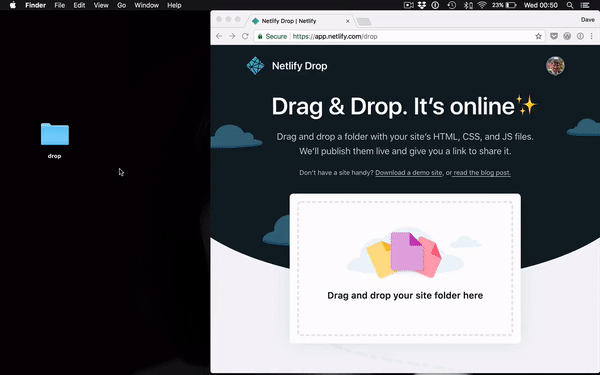

Alright, so I didn’t actually drop the mic on Netlify; I dropped a site on it. Netlify Drop is a tool where you can grab a folder containing a site or app or whatever and drop it straight into the Netlify hosting platform. You can read more about Drop on the Netlify blog.
Anyway, I saw their announcement and thought…
Hmm I really want to try this out, but what should I make?
And then it clicked… well, thudded - with a little audio feedback.
I started in a place where I often go to code obscure, but fun things: CodePen. Kicking things off with a bit of HTML:
So, I’ve got a mic and a hand to hold it neatly (if a little inaccessibly) wrapped in some span elements, but I need to sort out the presentation. There’s a set of styles that I almost always use when knocking together that needs to be front-and-centre, which is why I should probably throw these into a CodePen template, so I don’t have to write them every time:
body {
min-height: 100vh;
display: grid;
place-items: center;
font-size: 10vw;
}
What’s going on in the above CSS? Well, I’m selecting the body element and giving it a height of at least 100% of the browser height (viewport height, vh). Then, I’m harnessing the power of CSS Grid to centre any child elements within the body. I love the place-items shorthand property for centering grid items - totally stole that from a tweet by Benjamin De Cock. The last bit is a flippant attempt to scale the emojis with font-size in relation to the browser width (viewport width, vw).
These styles aren’t going to get the desired result, however. I need the hand to overlap the mic and rotate it a little to give the impression that it’s holding the mic:
span {
grid-area: 1 / 1;
}
.hand {
cursor: pointer;
transform: rotate(-38deg) translateX(-20%) translateY(1%);
}
In this part of the CSS, I’m using grid-area to place the hand and the mic in the same grid cell; it’s an excellent trick to overlap elements without using absolute positioning. That’s another one I stole from someone, but this time it was in the CSS Grid course by Wes Bos. Lastly, shown above are a few adjustments to the hand with some transform styles, as well as making sure the cursor pointer comes up when someone hovers over the hand (bad Dave! Very inaccessible).
Now, how to make this mic drop off the screen? For this, I’m going to employ the use of CSS custom properties:
.mic {
transition: 1s ease-in;
transform: translateY(var(--drop, 0)) rotate(var(--spin, 0deg));
}
With these styles, the .mic (the mic 🎤) will look no different and won’t do anything. However, it’s ready to take onboard two custom properties, --drop and --spin. These custom properties have also been setup with defaults to make sure they have a starting point: var(--drop, 0) for the Y translation (moving downwards) and var(--spin, 0deg) for rotation (in degrees). The other property is to tell the element to transition between states, so the mic will move whenever I give it any property change, custom or not.
As the mic has been prepared for my two custom properties, I can now apply them when someone clicks on the hand with a bit of JavaScript:
document.querySelector('.hand').addEventListener('click', event => {
event.target.innerHTML = `✋`
document.querySelector('.mic').style = `--drop: 60vh; --spin: 900deg`
})
I’ve got a habit of writing short, but sometimes hard to read JavaScript, so maybe this will help you understand what I’m doing:
const hand = document.querySelector('.hand');
const mic = document.querySelector('.mic');
hand.addEventListener('click', () => {
hand.innerHTML = `✋`
mic.style = `--drop: 60vh; --spin: 900deg`
})
In the cleaner presentation above, I’m selecting both the hand and mic span elements and naming them, respectively. To the hand I’m adding an event listener, so I know when a click happens on it. Two things will then happen when the hand is clicked:
span will be changed to an open hand ✋style attribute will be added to the mic span with a value that contains new values for my custom CSS properties, --drop: 60vh and --spin: 900degWith this in place, the hand will ‘open’ and the mic will drop down 60vh (60% of the viewport browser height) and spin 900 degrees. I realise now that 900 degrees for a mic to spin after someone dropping it is a bit excessive, unless it was Tony Hawk dropping it.
The final slot of the puzzle was using what I mentioned at the start, Netlify Drop:

You can find the final resulting hosted site at https://mic-drop.netlify.com
This was really fun to make, and thanks to all these great tools and development features, it only took 20 minutes or so to complete. There have been so many people responding to it on Twitter and it’s great to see people enjoying it and having a laugh.
This subheading sounds ominous, as if I’m going to make it into some kind of SaaS product or something. Well, I can tell you now, that’s not my plan - I want to use it for learning purposes. There are some things I want to try out which include a couple of the other useful features Netlify provides. Here’s what I’m thinking:
vh tries to keep up. Sadly, Safari iOS is pretty bad at this and there has been quite a bit of work to work around the bugUpdate: the items marked ☑️ I’ve now done
Alright, I think that’s everything. I’ve gone on for too long now. Thanks for reading! If you liked this, then feel free to share it or send me a nice tweet.